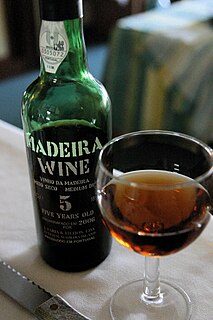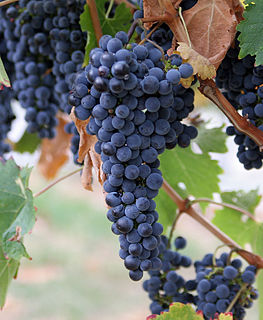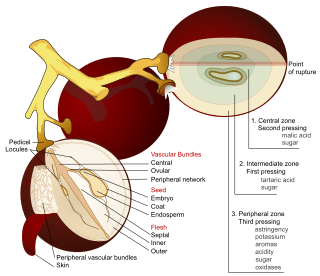
Tintilia is a red Italian wine grape variety that is grown in the Molise region of east-central Italy. A red wine made from the grape was classified as Denominazione di origine controllata (DOC) in 2011.

Tintilia is a red Italian wine grape variety that is grown in the Molise region of east-central Italy. A red wine made from the grape was classified as Denominazione di origine controllata (DOC) in 2011.
Its name probably comes from Italian "tinta", which means "dye".
The area of production of the grapes for the production of wines with D.O.C. “Tintilia del Molise”, include lands suited to quality and suitable for the cultivation of grapevines in the provinces of Campobasso and Isernia.
The D.O.C. “Tintilia del Molise” is reserved for those wines meeting the conditions and requirements established by this production regulations for the following types:
Wines with D.O.C. “Tintilia del Molise” must be produced from grapes grown in vineyards consisting, in the farm area, of at least 95% Tintilia vines. To produce these wines can also be used other non-aromatic grapes suitable for cultivation in the provinces of Campobasso and Isernia, existing in the farm vineyards, alone or in combination, up to a maximum of 5%.
The D.O.C. “Tintilia del Molise” wines, when entering the market, must match the following characteristics:
“Tintilia del Molise” Red wine:
“Tintilia del Molise” Rosé wine:
“Tintilia del Molise” Red Reserve wine:

Madeira is a fortified wine made on the Portuguese Madeira Islands, off the coast of Africa. Madeira is produced in a variety of styles ranging from dry wines which can be consumed on their own as an aperitif to sweet wines usually consumed with dessert. Cheaper cooking versions are often flavoured with salt and pepper for use in cooking, but these are not fit for consumption as a beverage.

Molise is a region of Southern Italy. Until 1963, it formed part of the region of Abruzzi e Molise, alongside the region of Abruzzo. The split, which did not become effective until 1970, makes Molise the youngest region in Italy. Covering 4,438 square kilometres (1,714 sq mi), it is the second smallest region in the country after the Aosta Valley, and has a population of 313,348.

Winemaking or vinification is the production of wine, starting with the selection of the fruit, its fermentation into alcohol, and the bottling of the finished liquid. The history of wine-making stretches over millennia. The science of wine and winemaking is known as oenology. A winemaker may also be called a vintner. The growing of grapes is viticulture and there are many varieties of grapes.

White wine is a wine that is fermented without skin contact. The colour can be straw-yellow, yellow-green, or yellow-gold. It is produced by the alcoholic fermentation of the non-coloured pulp of grapes, which may have a skin of any colour. White wine has existed for at least 2500 years.

The subjective sweetness of a wine is determined by the interaction of several factors, including the amount of sugar in the wine, but also the relative levels of alcohol, acids, and tannins. Sugars and alcohol enhance a wine's sweetness; acids (sourness) and bitter tannins counteract it. These principles are outlined in the 1987 work by Émile Peynaud, The Taste of Wine.

The province of Isernia is a province in the region of Molise in Italy. The provincial capital is the city Isernia and the president of the province is Alfredo Ricci. The province of Isernia has an area of 1,535.24 square kilometres (592.76 sq mi) and a population of 86,405 inhabitants as of 2016. It contains 52 comunes in the province, listed at comunes of the Province of Isernia.
The glossary of wine terms lists the definitions of many general terms used within the wine industry. For terms specific to viticulture, winemaking, grape varieties, and wine tasting, see the topic specific list in the "See also" section below.

Saperavi is an acidic, teinturier-type grape variety native to the country of Georgia, where it is used to make many of the region's most well-known wines. It is also grown in Armenia, Moldova, Ukraine, Uzbekistan, Azerbaijan, and in small quantities in the Niagara and Finger Lakes regions of New York State. Its leaves are 3-lobed, large, and roundish. The berries are medium to large, elliptic or round depending on the type, dark bluish, and thin-skinned; with a maturation period of approximately 5 months and moderate productivity.

Georgia is one of the oldest wine regions in the world. The fertile valleys and protective slopes of the Transcaucasia were home to grapevine cultivation and neolithic wine production for at least 8000 years. Due to the many millennia of wine in Georgian history and its prominent economic role, the traditions of wine are considered entwined with and inseparable from the national identity.
Brindisi Rosso is a red DOC wine from the Southern Italian province of Brindisi, in the region of Apulia. The official appellation was granted on November 22, 1979, when a presidential decree was published in the Gazzetta Ufficiale dated April 23, 1980, after lobbying by the firm of Pasquale Medico & Sons and other producers. In recent years the production of this variety of wine has declined considerably, due to the uprooting of vines as a result of incentives from the EU, which has favoured other products. The province of Brindisi has a very long tradition of wine making, largely because Brindisi was the Roman gateway to the East and sold its wine to Rome along with salt and olive oil imported from the empire's Mediterranean provinces.

Montepulciano is a red Italian wine grape variety that is most noted for being the primary grape behind the DOCG wines Offida Rosso, Montepulciano d'Abruzzo, Montepulciano d'Abruzzo Colline Teramane, Rosso Conero and the DOC wine Rosso Piceno Superiore.

Abkhazia is a disputed region in Georgia, but currently self-proclaimed an independent state. It has a long history of wine-making. Most of the produced wine is consumed locally or exported to Russia.
The use of wine tasting descriptors allows the taster to qualitatively relate the aromas and flavors that the taster experiences and can be used in assessing the overall quality of wine. Wine writers differentiate wine tasters from casual enthusiasts; tasters attempt to give an objective description of the wine's taste, casual enthusiasts appreciate wine but pause their examination sooner than tasters. The primary source of a person's ability to taste wine is derived from their olfactory senses. A taster's own personal experiences play a significant role in conceptualizing what they are tasting and attaching a description to that perception. The individual nature of tasting means that descriptors may be perceived differently among various tasters.

The acids in wine are an important component in both winemaking and the finished product of wine. They are present in both grapes and wine, having direct influences on the color, balance and taste of the wine as well as the growth and vitality of yeast during fermentation and protecting the wine from bacteria. The measure of the amount of acidity in wine is known as the “titratable acidity” or “total acidity”, which refers to the test that yields the total of all acids present, while strength of acidity is measured according to pH, with most wines having a pH between 2.9 and 3.9. Generally, the lower the pH, the higher the acidity in the wine. However, there is no direct connection between total acidity and pH. In wine tasting, the term “acidity” refers to the fresh, tart and sour attributes of the wine which are evaluated in relation to how well the acidity balances out the sweetness and bitter components of the wine such as tannins. Three primary acids are found in wine grapes: tartaric, malic and citric acids. During the course of winemaking and in the finished wines, acetic, butyric, lactic and succinic acids can play significant roles. Most of the acids involved with wine are fixed acids with the notable exception of acetic acid, mostly found in vinegar, which is volatile and can contribute to the wine fault known as volatile acidity. Sometimes, additional acids, such as ascorbic, sorbic and sulfurous acids, are used in winemaking.
This glossary of winemaking terms lists some of terms and definitions involved in making wine, fruit wine, and mead.

Slovak wine is produced in the southern part of Slovakia, which is divided into 6 wine-producing areas. Although Slovak wines except Tokaj are not well known internationally, they are popular domestically and in neighbouring countries.

Saint-Estèphe is an Appellation d'Origine Contrôlée (AOC) for red wine in the Bordeaux region, located in the Médoc subregion. It takes its name from the commune of Saint-Estèphe and is the northernmost of the six communal appellations in Médoc. Five classified growths of 1855 are located within the appellation area. Saint-Estèphe has held AOC recognition since 1936.

Montagne-Saint-Émilion is an Appellation d'origine contrôlée (AOC) for wine in the Bordeaux wine region of France, where it is situated in the Libourne subregion on the right bank of the Dordogne. It was granted AOC status on 14 November 1936, and the AOC designation granted to the wines which have been harvested on the land of the Montagne commune or in its hamlets, Parsac and Saint-Georges. 1,570 hectares of vine planted areas have belonged to the appellation in 2005, with a production of 74,130 hl.

Puisseguin-Saint-Émilion is an Appellation d'origine contrôlée (AOC) for wine in the Bordeaux wine region of France, where it is situated in the Libourne subregion on the right bank of the Dordogne. It was granted AOC status on 14 November 1936, and the AOC designation granted to the wines which have been harvested on the land of the Puisseguin commune. 753 hectares of vine planted areas have belonged to the appellation in 2005, with a production of 34,648 hl.

Saint-Georges-Saint-Émilion is an Appellation d'origine contrôlée (AOC) for wine in the Bordeaux wine region of France, where it is situated in the Libourne subregion on the right bank of the Dordogne. It was granted AOC status on 14 November 1936, and the AOC designation granted to the wines which have been harvested on the land of the Saint-Georges-Saint-Émilion hamlet, which is part of Montagne commune. 192 hectares of vine planted areas belonged to the appellation in 2005, with a production of 9,333 hl.